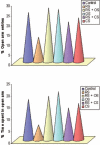Effects of Ocimum sanctum and Camellia sinensis on stress-induced anxiety and depression in male albino Rattus norvegicus
- PMID: 21206619
- PMCID: PMC2959210
- DOI: 10.4103/0253-7613.70108
Effects of Ocimum sanctum and Camellia sinensis on stress-induced anxiety and depression in male albino Rattus norvegicus
Abstract
Objective: The aim of this study was to study the ameliorative effects of Ocimum sanctum and Camellia sinensis on stress-induced anxiety and depression.
Materials and methods: The study was carried out using male albino rats (200 ± 50 g). The effect of O. sanctum and C. sinensis was evaluated for anxiety and depression using elevated plus maze (EPM) test, open field test (OFT), forced swim test (FST), and tail suspension test (TST).
Result: Restraint stress (3 h/day for six consecutive days) induced a significant reduction in both the percentage number of entries and time spent in open arms in EPM, and these changes were reversed with post-treatment of aqueous extract of O. sanctum and C. sinensis (100 mg/kg for 6 days). Restraint stress-induced (a) increased latency and (b) decreased ambulation and rearing were also reversed by O. sanctum and C. sinensis in OFT. A significant increase in immobility period was observed in FST and TST after restraint stress. O. sanctum and C. sinensis significantly reduced the immobility times of rats in FST and TST.
Conclusion: O. sanctum and C. sinensis possess anxiolytic and antidepressant activities.
Keywords: Anxiety; Camellia sinensis; Ocimum sanctum; depression; restraint stress.
Conflict of interest statement
Figures





Similar articles
-
Anxiolytic activity of aqueous extract of Camellia sinensis in rats.Indian J Pharmacol. 2016 Nov-Dec;48(6):681-686. doi: 10.4103/0253-7613.194864. Indian J Pharmacol. 2016. PMID: 28066107 Free PMC article.
-
Efficacy of Ocimum sanctum for relieving stress: a preclinical study.J Contemp Dent Pract. 2012 Nov 1;13(6):782-6. doi: 10.5005/jp-journals-10024-1229. J Contemp Dent Pract. 2012. PMID: 23404003
-
Effect of Beta vulgaris Linn. Leaves Extract on Anxiety- and Depressive-like Behavior and Oxidative Stress in Mice after Acute Restraint Stress.Pharmacognosy Res. 2016 Jan-Mar;8(1):1-7. doi: 10.4103/0974-8490.171100. Pharmacognosy Res. 2016. PMID: 26941529 Free PMC article.
-
Sericin alleviates restraint stress induced depressive- and anxiety-like behaviors via modulation of oxidative stress, neuroinflammation and apoptosis in the prefrontal cortex and hippocampus.Brain Res. 2019 Jul 15;1715:47-56. doi: 10.1016/j.brainres.2019.03.020. Epub 2019 Mar 18. Brain Res. 2019. PMID: 30898675
-
Antidepressant and anxiolytic-like behavioral effects of erucamide, a bioactive fatty acid amide, involving the hypothalamus-pituitary-adrenal axis in mice.Neurosci Lett. 2017 Feb 15;640:6-12. doi: 10.1016/j.neulet.2016.12.072. Epub 2017 Jan 10. Neurosci Lett. 2017. PMID: 28082151
Cited by
-
Evaluation of effect of allopurinol and febuxostat in behavioral model of depression in mice.Indian J Pharmacol. 2013 May-Jun;45(3):244-7. doi: 10.4103/0253-7613.111922. Indian J Pharmacol. 2013. PMID: 23833366 Free PMC article.
-
Effects of Camellia Sinensis Extract on Repeated Restraint Stress-Induced Ovariectomized Female Rats.Biomed Res Int. 2019 Jul 24;2019:1926352. doi: 10.1155/2019/1926352. eCollection 2019. Biomed Res Int. 2019. PMID: 31428628 Free PMC article.
-
Anxiolytic activity of aqueous extract of Camellia sinensis in rats.Indian J Pharmacol. 2016 Nov-Dec;48(6):681-686. doi: 10.4103/0253-7613.194864. Indian J Pharmacol. 2016. PMID: 28066107 Free PMC article.
-
Tulsi - Ocimum sanctum: A herb for all reasons.J Ayurveda Integr Med. 2014 Oct-Dec;5(4):251-9. doi: 10.4103/0975-9476.146554. J Ayurveda Integr Med. 2014. PMID: 25624701 Free PMC article. Review.
-
The Clinical Efficacy and Safety of Tulsi in Humans: A Systematic Review of the Literature.Evid Based Complement Alternat Med. 2017;2017:9217567. doi: 10.1155/2017/9217567. Epub 2017 Mar 16. Evid Based Complement Alternat Med. 2017. PMID: 28400848 Free PMC article. Review.
References
-
- Chrousos GP, Gold PW. The concepts of stress and stress system disorders. JAMA. 1992;267:1244–52. - PubMed
-
- Korte MS, Boer SF. A robust animal model of state anxiety: Fear-potentiated behavior in the elevated plus-maze. Eur J Pharmacol. 2003;463:163–75. - PubMed
-
- Garcia R. Stress, metaplasticity, and antidepressants. Curr Mol Med. 2002;2:629–38. - PubMed
-
- Gold PW, Goodwin FK, Chrousos GP. Clinical and biochemical manifestations of depression in relation to the neurobiology of stress: Part 1. N Engl J Med. 1988;319:348–53. - PubMed
-
- Porsolt RD, Bertin A, Jalfre M. Behavioral despair in mice: Primary screening test for antidepressants. Arch Int Pharmacodyn Ther. 1977;229:327–36. - PubMed
LinkOut - more resources
Full Text Sources
Miscellaneous

